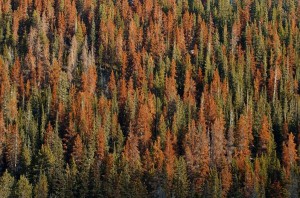This week’s blogger is Emily Robitschek, a proud graduate of Arvada West High School near Denver, Colorado. In this post she reports about her research project that she conducted while she worked in the GLOBE Program Office in the summer of 2011 as part of a high school research internship program (HIRO) at the University Corporation for Atmospheric Research. To read about her experience in this program, see her blog post from 28 March 2012. Emily just graduated from high school in May 2012 and is planning to attend Colorado State University in August.
The current mountain pine beetle outbreak spanning Colorado and southern Wyoming (previously reported on in this blog) has spread to 4 million acres since 1996 making it the largest recorded epidemic in these areas. Tree canopy loss within stands of affected pine trees is a symptom of this epidemic. Part of the loss occurs during the “red phase,” wherein the trees still retain red needles, and the remaining loss occurs during the “gray phase,” wherein the trees have shed all of their needles and some small branches. While these visually dramatic effects of the beetle epidemic are evident, how it influences specific environmental factors, such as hydrology and transmittance of solar radiation, is less understood.
Research is underway to comprehend any potential effects the pine beetle epidemic has on the environments in which it is prevalent. One such project, which I worked on during my summer internship with GLOBE, focused on studying solar radiation in affected and unaffected tree stands. A change in solar radiation transmittance through the canopy can have effects on the snowpack accumulation (or ablation), surface sensible and latent heat fluxes, and other energy and water balance parameters. To quantify and compare the levels of solar radiation transmitted through healthy pine canopies with transmittance through trees affected by pine beetles, we used data from pyranometers (instruments that measure solar radiation) to analyze healthy sites and a red phase site.
Our study found that, on average, the ratio of the solar radiation recorded by sensors that were placed directly under the canopy (“under”) to those placed in nearby open tree clearings (“open”) was closer to unity at the red phase site. This indicates that nearly the same amount of solar radiation was transmitted through the trees as was transmitted through the relatively treeless clearings. On the other hand, this ratio was reduced at most healthy sites, indicating that less solar radiation was being transmitted through the healthy tree canopies. Similar results were found by comparing the amount of solar radiation received at the top of the tree canopies (using pyranometer data from an instrumented tower) compared to that received below the tree canopies (the “under” sensors).
Thus, our results imply that more solar radiation was transmitted through the red phase canopy, perhaps due to its loss of needles. However, these results do not prove that pine needle loss caused more solar radiation to be transmitted. There are several other factors that could have led to these results that need to be considered, such as forest tree density, instrument placement, and other site specific details (i.e. altitude, slope angle, etc). Furthermore, additional sites need to be analyzed in order to more firmly establish these results and understand the variability within the various tree stands. Nonetheless, if the tree stands affected by pine beetles do allow more solar radiation to reach the ground below their canopies, that could lead to more snow melting and ultimately have effects on water storage and the hydrological and energy cycles in the region.
When beetles kill the trees, they impact the local land cover. Are there changes happening to your local land cover and if so, what effects of land cover change have you noticed in your community? Send us an email at science@globe.gov or post a comment to let us know!




People never care things before the lost them.
is the first time that I visit this site and I’ve enjoyed this information it’ll be happening oftener
Interesting article. We have Ash Dieback in the United Kingdom and it’s sadly killing thousands of 1000-year-old Ash trees. Some trees aren’t affected by the disease whereas some are.
I supposed with beetles they are far harder to spread than an infection like Ash Dieback?
Regards,
Garold Walker
I have actually been to this website a few times and have constantly found something new that I didn’t already know. Keep it up. I’ll be back.
Interesting article! I found this very informative, on the topic of renewable energy, what’s you thoughts on what Tesla is doing? By building the supercharger station as an H shape from California to New Jersey? What about the whole gigantic battery plan powered by solar and wind?? Plus Elon Musk other company, Solarcity?
Source came from. Tesla News
http://www.teslanews.net
I am a native Coloradoan and to see the damage that the Pine Beetle has done to our forests is heart wrenching. I think that few people understand that if we find a way to “spray” for the Pine Beetle we would then in turn be damaging other important ecosystems at the same time. This is a tremendously complicated issue. I had not even contemplated the fact that the thinner canopy would had and effect upon the snow pack and all of those ensuing issues. Climate change is a real issue that is happening. I do not understand how some don’t recognized it as such.
I’ve been to Colorado. This article just brought back those memories.
Sad to see what the beetle does to those lovely pine trees. In your first picture the scenery looks lovely I hope more is done to preserve these trees.